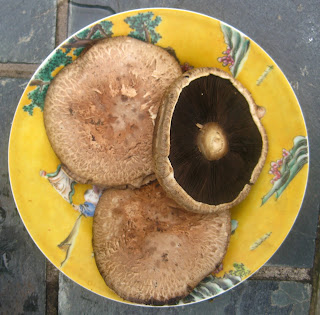It's a bit late in the year to be making it, but thanks to the fine autumn, last week there were still plenty of red peppers/capsicums, aubergine/eggplant and courgettes/zucchini around. (Interesting how all these relatively recent additions to our vege supply have at least two and often three or more names - French, Italian, English, sometimes American.) I use tinned tomatoes - even in high summer, unless you live somewhere warm and grow your own, we just don't get sufficiently ripe, red, luscious tomatoes. But it works best with plain crushed tomatoes, not flavoured ones.
I can and still sometimes do make the proper version, using lots and lots of olive oil. But I've also evolved a lighter one that fulfils what Julia Child says is the cardinal principle for this dish: cooking each vegetable separately first, then combining them briefly, to keep the true flavours. The one I made left out the eggplant. Harvey doesn't like it, and while I do, I prefer it cooked by itself in something like eggplant parmigiano. Besides, the colour does look very pretty without it.
You can make any quantity you like - all that matters is keeping a roughly even balance of veges. For my birthday, two very large brown onions, three large red peppers, three tins of tomatoes and about ten small courgettes, plus garlic and oil, made more than enough to feed 14 people as a side dish. The big white Spanish onions are by far the best to use, but even Moore Wilson doesn't seem to have them any more. If anyone knows how I can get them in Wellington, please let me know.
Revised Ratatouille
Large brown onions - or red ones if you prefer, but peel off the tough outer skins
Extra virgin olive oil
Well-ripened sweet peppers - I like red but you can use orange, yellow, or all three
Small/medium courgettes
New Zealand garlic
Extra virgin olive oil - not Spanish
Black pepper and salt
Sugar (optional)
Flat-leafed parsley
Put the onions and garlic and a good gloop of oil (depending on how much onion you have) into a wide shallow ceramic or glass dish and cover for the microwave (I use a rubber and plastic lid, it saves having to use plastic clingwrap). Cook for a few minutes until just tender (I use the "fresh veges" setting). Remove to another bowl and set aside.
Use the same dish to cook the peppers until they're softened but not limp, with another gloop of oil, and set aside. Drain and rinse the courgettes, and cook the same way - no need to add more oil to them, the drops of rinsing water are enough. Be careful to just cook them, they shouldn't be completely limp. You can make it all in advance to this point.
Gently heat a large wide frypan - non-stick is good - with another tablespoon of oil, and put in each vege in alternate layers, sprinkling a little chopped parsley over each layer. Add enough tinned, crushed tomatoes to provide moisture and a good balance of flavours. Heat gently through, and add freshly ground black pepper and salt to taste. A very small teaspoon of sugar can be a good addition at this point (especially if the peppers were not deeply coloured and ripe).
This is good by itself with crusty bread, or to go with roast chicken, beef or lamb. It can be served either hot, warm or cold. You can add pieces of fresh lean chicken to any leftovers to make a quick chicken stew, or use it as a pasta sauce.




















